 From my final practicum, a depression simulation activity which generated a most satisfying degree of student excitement and engagement. The activity combined review of historical facts and trends with randomized maj
From my final practicum, a depression simulation activity which generated a most satisfying degree of student excitement and engagement. The activity combined review of historical facts and trends with randomized maj or life events appropriate to the time period drawn from different decks depending on one’s station in life at the start of the turn. The activity got students using numeracy to keep a budget, writing and reflective skills as part of the post-activity self-assessment, and succesfully introduced new ideas and realities to students.
or life events appropriate to the time period drawn from different decks depending on one’s station in life at the start of the turn. The activity got students using numeracy to keep a budget, writing and reflective skills as part of the post-activity self-assessment, and succesfully introduced new ideas and realities to students.
I ran mock trials with my grade 8 classes during my final practicum. Holding mock trials in the classroom is, I think, a fairly commonplace classroom activity when introducing students to Canadian law, but I think that applying the format to 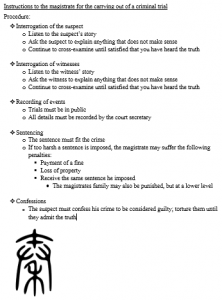 dynastic Chinese law was a rather creative approach on my part. It was also a tremendous amount of work, with hours spent seeking out translations and poring over 1000+ year old court summaries. Well worth the effort for the payoff in class, though. Much fun was had by participating students, with the activity serving to reinforce prior learning on the subject of Chinese legalism. I realized it only after the fact, but this activity also serves a useful formative assessment purpose: in all six trials held in two separate classes the sentences pronounced by the student magistrate/emperor were remarkably close to the historical resolution, showing a more than satisfactory understanding of what I had been teaching.
dynastic Chinese law was a rather creative approach on my part. It was also a tremendous amount of work, with hours spent seeking out translations and poring over 1000+ year old court summaries. Well worth the effort for the payoff in class, though. Much fun was had by participating students, with the activity serving to reinforce prior learning on the subject of Chinese legalism. I realized it only after the fact, but this activity also serves a useful formative assessment purpose: in all six trials held in two separate classes the sentences pronounced by the student magistrate/emperor were remarkably close to the historical resolution, showing a more than satisfactory understanding of what I had been teaching.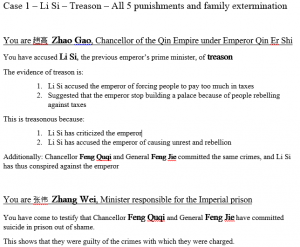
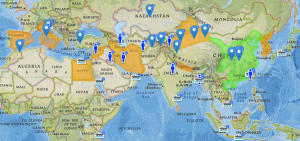
My grade 8 classes also explored the Silk Road online, practicing their research skills and identifying historically important regions, inventions, and trade routes. Students placed the results of their research as overlays on a digital map of the world to create their own informative presentations on the ancient Silk Road.
On the subject of exploring old things with new technology, my grade 10 class spent some time online looking at scanned Prince George newspapers from the 1920s. No better way to understand the past than to immerse oneself in it, and no better way  to feel the difference between then and now than to study how the place most familiar to one has changed. Students were tasked with finding, summarizing, and citing articles pertaining to a selection of topics (politics, entertainment, ads, etc.). This activity led into a larger project for which students prepared their own 1920s newspaper front pages relating to topics, such as the Winnipeg General Strike, that corresponded to the topics of individual lessons.
to feel the difference between then and now than to study how the place most familiar to one has changed. Students were tasked with finding, summarizing, and citing articles pertaining to a selection of topics (politics, entertainment, ads, etc.). This activity led into a larger project for which students prepared their own 1920s newspaper front pages relating to topics, such as the Winnipeg General Strike, that corresponded to the topics of individual lessons.
Whenever I’m guiding a group of learners through a historical topic, I try to give them exposure to primary sources. There is no shortage of educational material available for most topics that are likely to appear in the curriculum, but there really 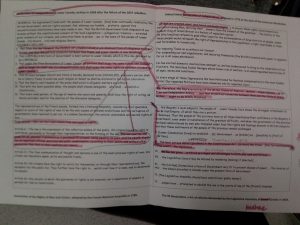 is no replacement for the ability to draw one’s own conclusions from as near to the events in question as one can get. It’s a completly different skill from being able to decide the relative merits of different interpretive points of view, and the ability to decide for oneself on the basis of evidence is an important life skill in a media saturated environment. During my (sadly shortened due to strike action) four week practicum, I helped grade 9 social studies students develop their source interpretation skills by comparing curated historical documents to determine whether or not the 1837 and 1838 rebellions in Upper and Lower Canada constituted revolutionary events. The time pressure of a shortened practicum prevented the class from delving as deeply into the topic as I would have liked, but the activity nevertheless led to a variety of interpretations with textual backing. I used primary sources with the class several times over the period of two weeks, and perhaps the biggest surprise was the lack of pushback–whether they were just enjoying something different or appreciated the challenge, student response was overwhelmingly positive. The importance of being willing to challenge students really became clear to me as a result of this and similar activities.
is no replacement for the ability to draw one’s own conclusions from as near to the events in question as one can get. It’s a completly different skill from being able to decide the relative merits of different interpretive points of view, and the ability to decide for oneself on the basis of evidence is an important life skill in a media saturated environment. During my (sadly shortened due to strike action) four week practicum, I helped grade 9 social studies students develop their source interpretation skills by comparing curated historical documents to determine whether or not the 1837 and 1838 rebellions in Upper and Lower Canada constituted revolutionary events. The time pressure of a shortened practicum prevented the class from delving as deeply into the topic as I would have liked, but the activity nevertheless led to a variety of interpretations with textual backing. I used primary sources with the class several times over the period of two weeks, and perhaps the biggest surprise was the lack of pushback–whether they were just enjoying something different or appreciated the challenge, student response was overwhelmingly positive. The importance of being willing to challenge students really became clear to me as a result of this and similar activities.
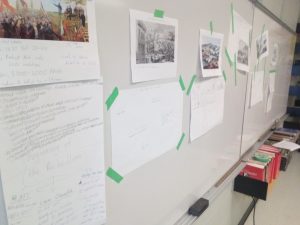 As part of the same unit, the class developed a collaborative timeline of the 1837 rebellions, interpreting images, practicing their ability to pull relevant and essential information from secondary sources, and presenting findings to the class. Students worked in small groups with pre-selected information packages and assigned images, and upon completion were responsible f
As part of the same unit, the class developed a collaborative timeline of the 1837 rebellions, interpreting images, practicing their ability to pull relevant and essential information from secondary sources, and presenting findings to the class. Students worked in small groups with pre-selected information packages and assigned images, and upon completion were responsible f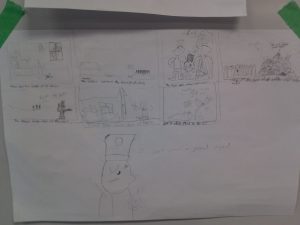 or arranging their mini-posters in chronological order on the classroom’s non-permanent vertical surface. Given freedom to choose their own format, some students opted for a variety of styles from densely packed information t
or arranging their mini-posters in chronological order on the classroom’s non-permanent vertical surface. Given freedom to choose their own format, some students opted for a variety of styles from densely packed information t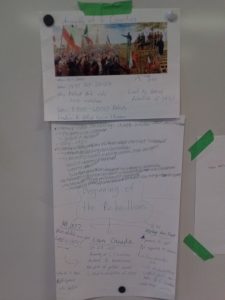 o comic strips. This activity unfolded within a single class as a formative exercise learning exercise, again due to the temporal limitations of a shortened practicum. When I do this activity again, I would like to extend it to a two or three day independent research assignment with a summative component. By far the most rewarding part of the exercise was seeing students who were habitually difficult to engage fully commit to the work.
o comic strips. This activity unfolded within a single class as a formative exercise learning exercise, again due to the temporal limitations of a shortened practicum. When I do this activity again, I would like to extend it to a two or three day independent research assignment with a summative component. By far the most rewarding part of the exercise was seeing students who were habitually difficult to engage fully commit to the work.

Another activity from my second practicum (alas, there are no pictures from the first; I am a terrible self-promoter). To introduce the War of 1812, the class interpreted images depicting important battles and locations from the conflict. Students broke off into groups, and rotated through each source, adding to the ideas and interpretations written down by previous groups. Student comments were the basis of a discussion about what might have happened during the war or been otherwise important. After actually learning about the war, it was time to go back to the images and connect them to what had been learned, using the pictures to both reinforce what had been studied and as a tool for further interpretation.

Here’s an oldie from my days as a shop teacher in northern Alberta. Combining function and decoration with birdhouses, and a great example of how even a technical course like woodshop can lend itself to broad crosscurricular connections. This project was also an opportunity to discuss local avian species, and their habitats, preferences, and needs.

Another project from back in my woodshop days. This picture is actually something of a two for one. In the foreground is a shelf built by a grade 7 student, which was designed to introduce as many different tools as possible while introducing a design that was, in its essentials, of a practical, around-the-house nature. In the background is a stack of picnic tables (yes, a stack; storage space was limited) built by the year’s grade 12 class and later sold for more than I expected as a fundraiser for the graduation ceremony.
